Accounting System and Process Assignment for Finance Students
VerifiedAdded on 2023/06/04
|19
|2548
|360
Homework Assignment
AI Summary
This accounting assignment solution provides a detailed analysis of various accounting concepts and processes. Part A focuses on the advantages and disadvantages of using spreadsheets in accounting, including data organization, computations, and security concerns. Part B delves into inventory management, comparing perpetual and periodic inventory systems, and applying FIFO, LIFO, and average cost methods to calculate ending inventory and cost of goods sold for Fashion Haven. Part C addresses bank reconciliation, including correcting bank errors and preparing journal entries. Finally, Part D explores bad debt management, comparing the allowance and write-off methods, and analyzing financial ratios (net profit, current, and debt-equity) and profitability charts to assess a company's financial performance and position, ultimately recommending investment decisions based on the analysis of Coca-Cola Amatil.
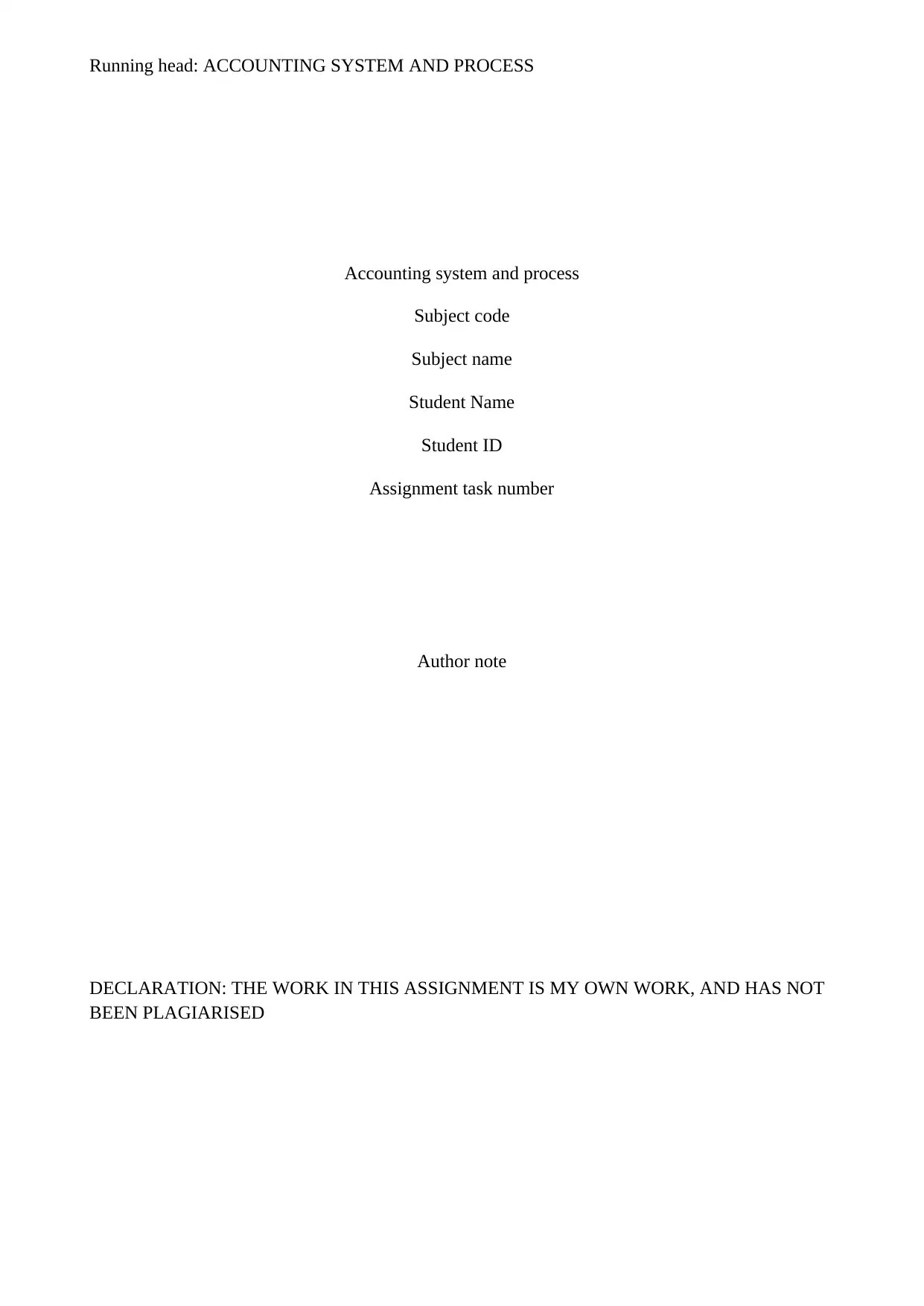
Running head: ACCOUNTING SYSTEM AND PROCESS
Accounting system and process
Subject code
Subject name
Student Name
Student ID
Assignment task number
Author note
DECLARATION: THE WORK IN THIS ASSIGNMENT IS MY OWN WORK, AND HAS NOT
BEEN PLAGIARISED
Accounting system and process
Subject code
Subject name
Student Name
Student ID
Assignment task number
Author note
DECLARATION: THE WORK IN THIS ASSIGNMENT IS MY OWN WORK, AND HAS NOT
BEEN PLAGIARISED
Paraphrase This Document
Need a fresh take? Get an instant paraphrase of this document with our AI Paraphraser

ACCOUNTING SYSTEM AND PROCESS
Table of Contents
Part A – Spreadsheet............................................................................................................................2
Part B – Inventory management..........................................................................................................7
Part C – Bank reconciliation..............................................................................................................12
Part D – Management of bad debt and financial decision.................................................................14
Reference...........................................................................................................................................17
Student name
Student ID Page 1
Table of Contents
Part A – Spreadsheet............................................................................................................................2
Part B – Inventory management..........................................................................................................7
Part C – Bank reconciliation..............................................................................................................12
Part D – Management of bad debt and financial decision.................................................................14
Reference...........................................................................................................................................17
Student name
Student ID Page 1
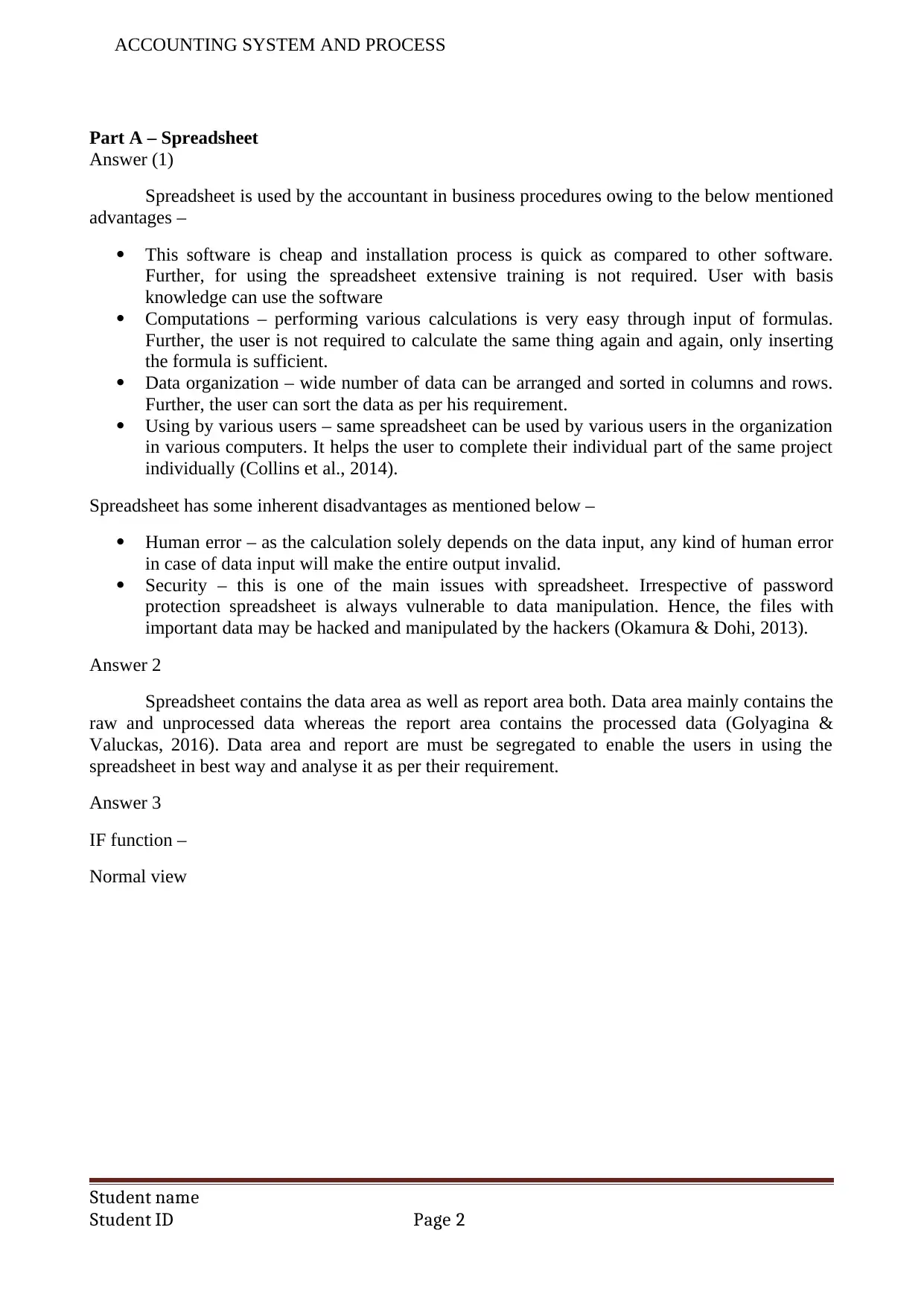
ACCOUNTING SYSTEM AND PROCESS
Part A – Spreadsheet
Answer (1)
Spreadsheet is used by the accountant in business procedures owing to the below mentioned
advantages –
This software is cheap and installation process is quick as compared to other software.
Further, for using the spreadsheet extensive training is not required. User with basis
knowledge can use the software
Computations – performing various calculations is very easy through input of formulas.
Further, the user is not required to calculate the same thing again and again, only inserting
the formula is sufficient.
Data organization – wide number of data can be arranged and sorted in columns and rows.
Further, the user can sort the data as per his requirement.
Using by various users – same spreadsheet can be used by various users in the organization
in various computers. It helps the user to complete their individual part of the same project
individually (Collins et al., 2014).
Spreadsheet has some inherent disadvantages as mentioned below –
Human error – as the calculation solely depends on the data input, any kind of human error
in case of data input will make the entire output invalid.
Security – this is one of the main issues with spreadsheet. Irrespective of password
protection spreadsheet is always vulnerable to data manipulation. Hence, the files with
important data may be hacked and manipulated by the hackers (Okamura & Dohi, 2013).
Answer 2
Spreadsheet contains the data area as well as report area both. Data area mainly contains the
raw and unprocessed data whereas the report area contains the processed data (Golyagina &
Valuckas, 2016). Data area and report are must be segregated to enable the users in using the
spreadsheet in best way and analyse it as per their requirement.
Answer 3
IF function –
Normal view
Student name
Student ID Page 2
Part A – Spreadsheet
Answer (1)
Spreadsheet is used by the accountant in business procedures owing to the below mentioned
advantages –
This software is cheap and installation process is quick as compared to other software.
Further, for using the spreadsheet extensive training is not required. User with basis
knowledge can use the software
Computations – performing various calculations is very easy through input of formulas.
Further, the user is not required to calculate the same thing again and again, only inserting
the formula is sufficient.
Data organization – wide number of data can be arranged and sorted in columns and rows.
Further, the user can sort the data as per his requirement.
Using by various users – same spreadsheet can be used by various users in the organization
in various computers. It helps the user to complete their individual part of the same project
individually (Collins et al., 2014).
Spreadsheet has some inherent disadvantages as mentioned below –
Human error – as the calculation solely depends on the data input, any kind of human error
in case of data input will make the entire output invalid.
Security – this is one of the main issues with spreadsheet. Irrespective of password
protection spreadsheet is always vulnerable to data manipulation. Hence, the files with
important data may be hacked and manipulated by the hackers (Okamura & Dohi, 2013).
Answer 2
Spreadsheet contains the data area as well as report area both. Data area mainly contains the
raw and unprocessed data whereas the report area contains the processed data (Golyagina &
Valuckas, 2016). Data area and report are must be segregated to enable the users in using the
spreadsheet in best way and analyse it as per their requirement.
Answer 3
IF function –
Normal view
Student name
Student ID Page 2
⊘ This is a preview!⊘
Do you want full access?
Subscribe today to unlock all pages.

Trusted by 1+ million students worldwide
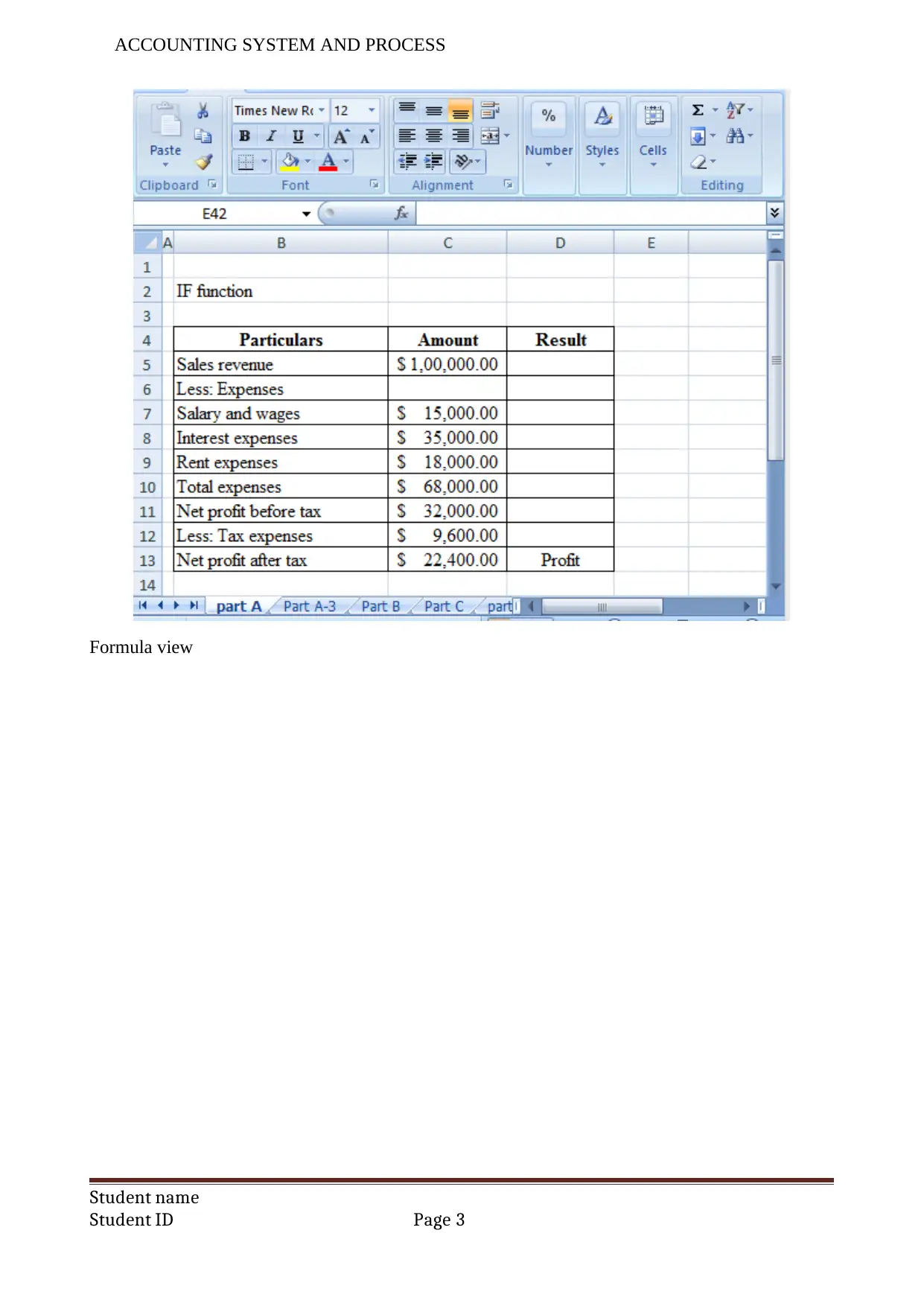
ACCOUNTING SYSTEM AND PROCESS
Formula view
Student name
Student ID Page 3
Formula view
Student name
Student ID Page 3
Paraphrase This Document
Need a fresh take? Get an instant paraphrase of this document with our AI Paraphraser

ACCOUNTING SYSTEM AND PROCESS
Negative number within bracket
Normal view
Student name
Student ID Page 4
Negative number within bracket
Normal view
Student name
Student ID Page 4
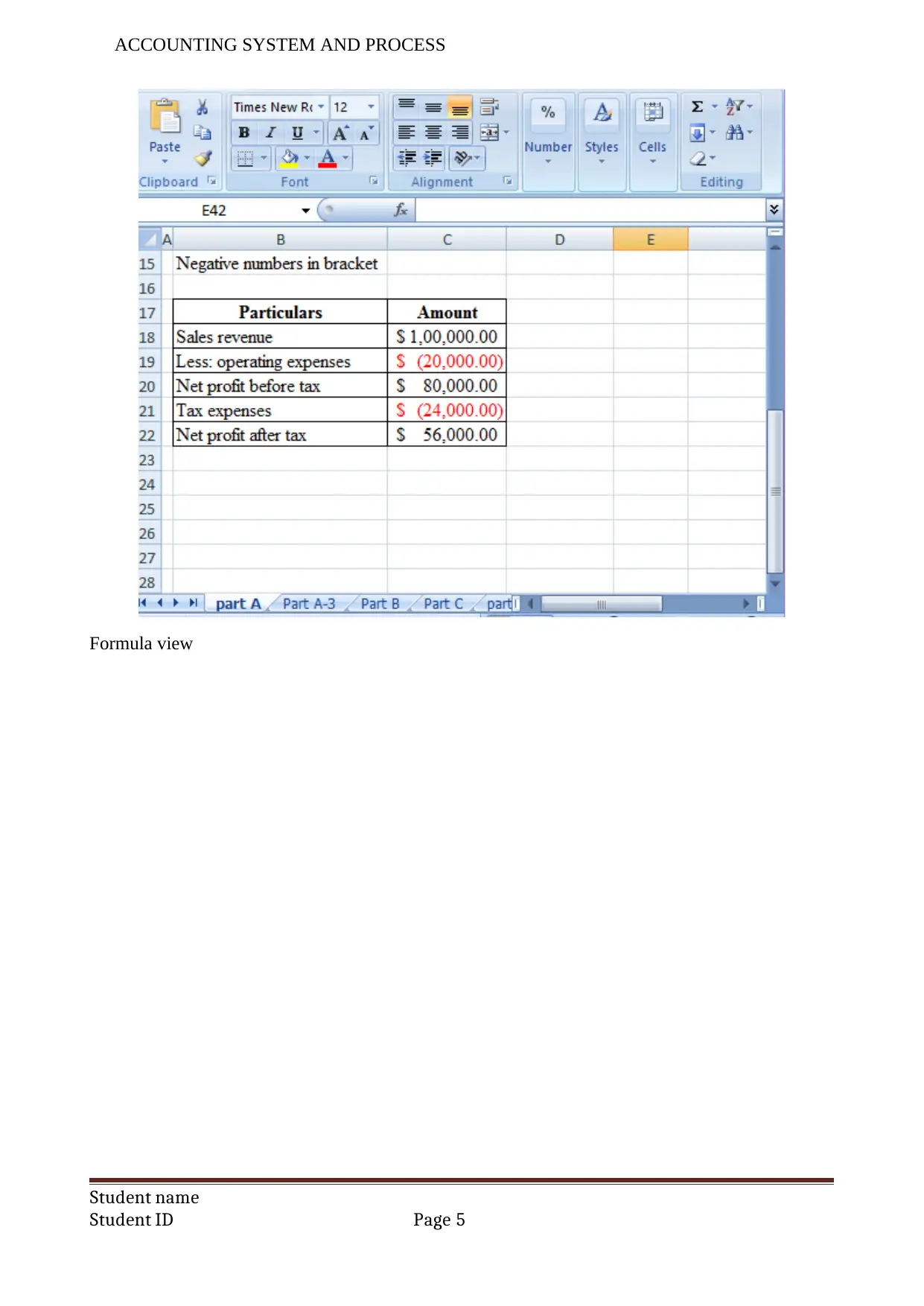
ACCOUNTING SYSTEM AND PROCESS
Formula view
Student name
Student ID Page 5
Formula view
Student name
Student ID Page 5
⊘ This is a preview!⊘
Do you want full access?
Subscribe today to unlock all pages.

Trusted by 1+ million students worldwide
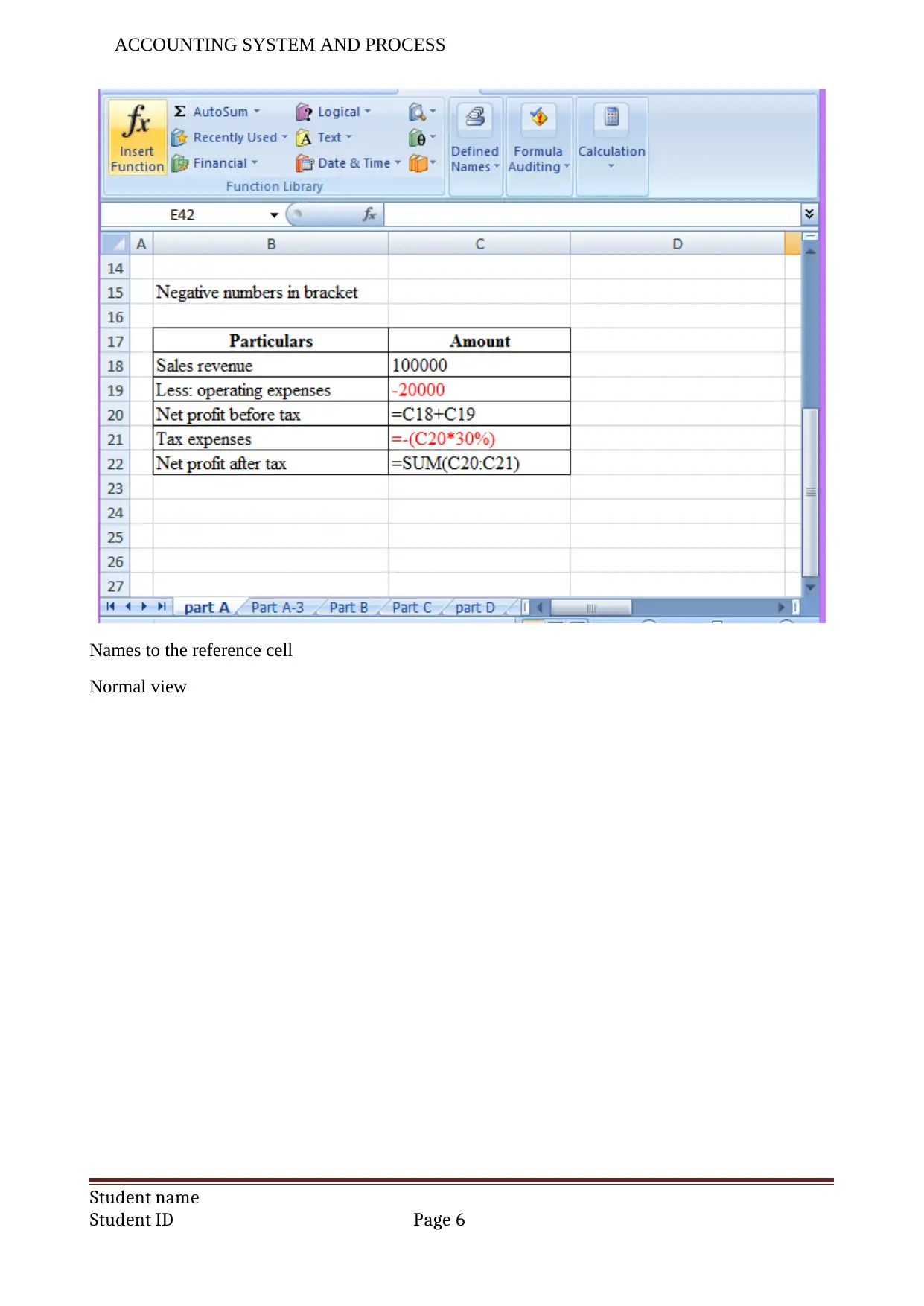
ACCOUNTING SYSTEM AND PROCESS
Names to the reference cell
Normal view
Student name
Student ID Page 6
Names to the reference cell
Normal view
Student name
Student ID Page 6
Paraphrase This Document
Need a fresh take? Get an instant paraphrase of this document with our AI Paraphraser

ACCOUNTING SYSTEM AND PROCESS
Formula view
Student name
Student ID Page 7
Formula view
Student name
Student ID Page 7
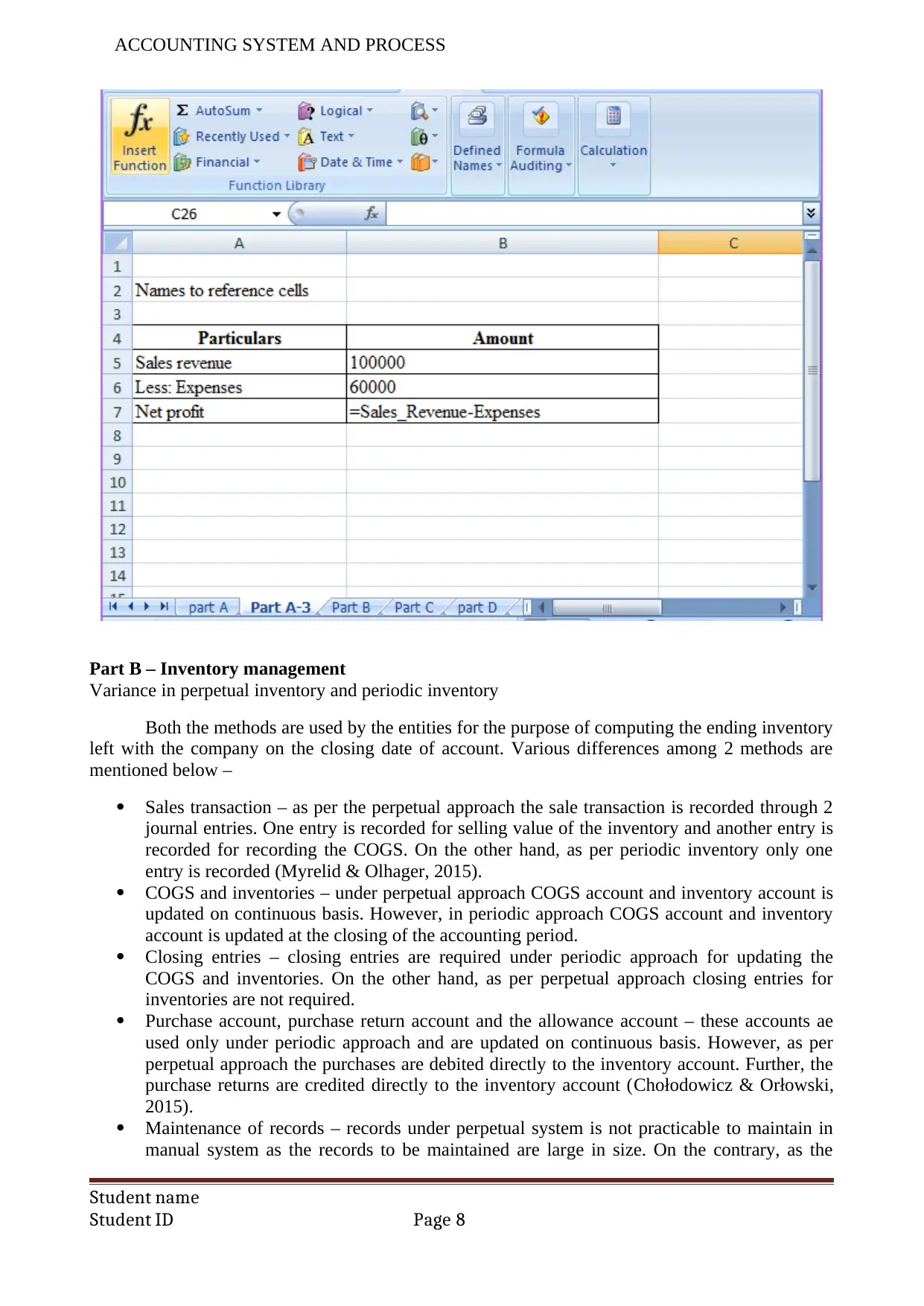
ACCOUNTING SYSTEM AND PROCESS
Part B – Inventory management
Variance in perpetual inventory and periodic inventory
Both the methods are used by the entities for the purpose of computing the ending inventory
left with the company on the closing date of account. Various differences among 2 methods are
mentioned below –
Sales transaction – as per the perpetual approach the sale transaction is recorded through 2
journal entries. One entry is recorded for selling value of the inventory and another entry is
recorded for recording the COGS. On the other hand, as per periodic inventory only one
entry is recorded (Myrelid & Olhager, 2015).
COGS and inventories – under perpetual approach COGS account and inventory account is
updated on continuous basis. However, in periodic approach COGS account and inventory
account is updated at the closing of the accounting period.
Closing entries – closing entries are required under periodic approach for updating the
COGS and inventories. On the other hand, as per perpetual approach closing entries for
inventories are not required.
Purchase account, purchase return account and the allowance account – these accounts ae
used only under periodic approach and are updated on continuous basis. However, as per
perpetual approach the purchases are debited directly to the inventory account. Further, the
purchase returns are credited directly to the inventory account (Chołodowicz & Orłowski,
2015).
Maintenance of records – records under perpetual system is not practicable to maintain in
manual system as the records to be maintained are large in size. On the contrary, as the
Student name
Student ID Page 8
Part B – Inventory management
Variance in perpetual inventory and periodic inventory
Both the methods are used by the entities for the purpose of computing the ending inventory
left with the company on the closing date of account. Various differences among 2 methods are
mentioned below –
Sales transaction – as per the perpetual approach the sale transaction is recorded through 2
journal entries. One entry is recorded for selling value of the inventory and another entry is
recorded for recording the COGS. On the other hand, as per periodic inventory only one
entry is recorded (Myrelid & Olhager, 2015).
COGS and inventories – under perpetual approach COGS account and inventory account is
updated on continuous basis. However, in periodic approach COGS account and inventory
account is updated at the closing of the accounting period.
Closing entries – closing entries are required under periodic approach for updating the
COGS and inventories. On the other hand, as per perpetual approach closing entries for
inventories are not required.
Purchase account, purchase return account and the allowance account – these accounts ae
used only under periodic approach and are updated on continuous basis. However, as per
perpetual approach the purchases are debited directly to the inventory account. Further, the
purchase returns are credited directly to the inventory account (Chołodowicz & Orłowski,
2015).
Maintenance of records – records under perpetual system is not practicable to maintain in
manual system as the records to be maintained are large in size. On the contrary, as the
Student name
Student ID Page 8
⊘ This is a preview!⊘
Do you want full access?
Subscribe today to unlock all pages.

Trusted by 1+ million students worldwide

ACCOUNTING SYSTEM AND PROCESS
records to be maintained are small in size in periodic approach it can be maintained
manually and computer both.
Recognition of error – recognition of error under perpetual approach is near to impossible as
the records to be maintained are large in size. On the contrary, recognition of error is easy
under periodic approach (Hoggett et al., 2015).
From the given case of Fashion Haven, it can be identified that the company deals in
fashion clothing. Owing to the nature of the business it carries on it has large number of purchase
and sales transaction throughout the year. Therefore, to maintain the records of inventory and
COGS on updated basis the company shall use perpetual approach. Though it has to maintain large
number of data and records, it will enable them to keep the updated track for the inventories. It will
further, help them to check the inventories before accepting any new order.
Calculation of ending inventory and COGS for the month of May
FIFO method –
Normal view –
Student name
Student ID Page 9
records to be maintained are small in size in periodic approach it can be maintained
manually and computer both.
Recognition of error – recognition of error under perpetual approach is near to impossible as
the records to be maintained are large in size. On the contrary, recognition of error is easy
under periodic approach (Hoggett et al., 2015).
From the given case of Fashion Haven, it can be identified that the company deals in
fashion clothing. Owing to the nature of the business it carries on it has large number of purchase
and sales transaction throughout the year. Therefore, to maintain the records of inventory and
COGS on updated basis the company shall use perpetual approach. Though it has to maintain large
number of data and records, it will enable them to keep the updated track for the inventories. It will
further, help them to check the inventories before accepting any new order.
Calculation of ending inventory and COGS for the month of May
FIFO method –
Normal view –
Student name
Student ID Page 9
Paraphrase This Document
Need a fresh take? Get an instant paraphrase of this document with our AI Paraphraser

ACCOUNTING SYSTEM AND PROCESS
Formula view –
LIFO method –
Normal view –
Student name
Student ID Page 10
Formula view –
LIFO method –
Normal view –
Student name
Student ID Page 10
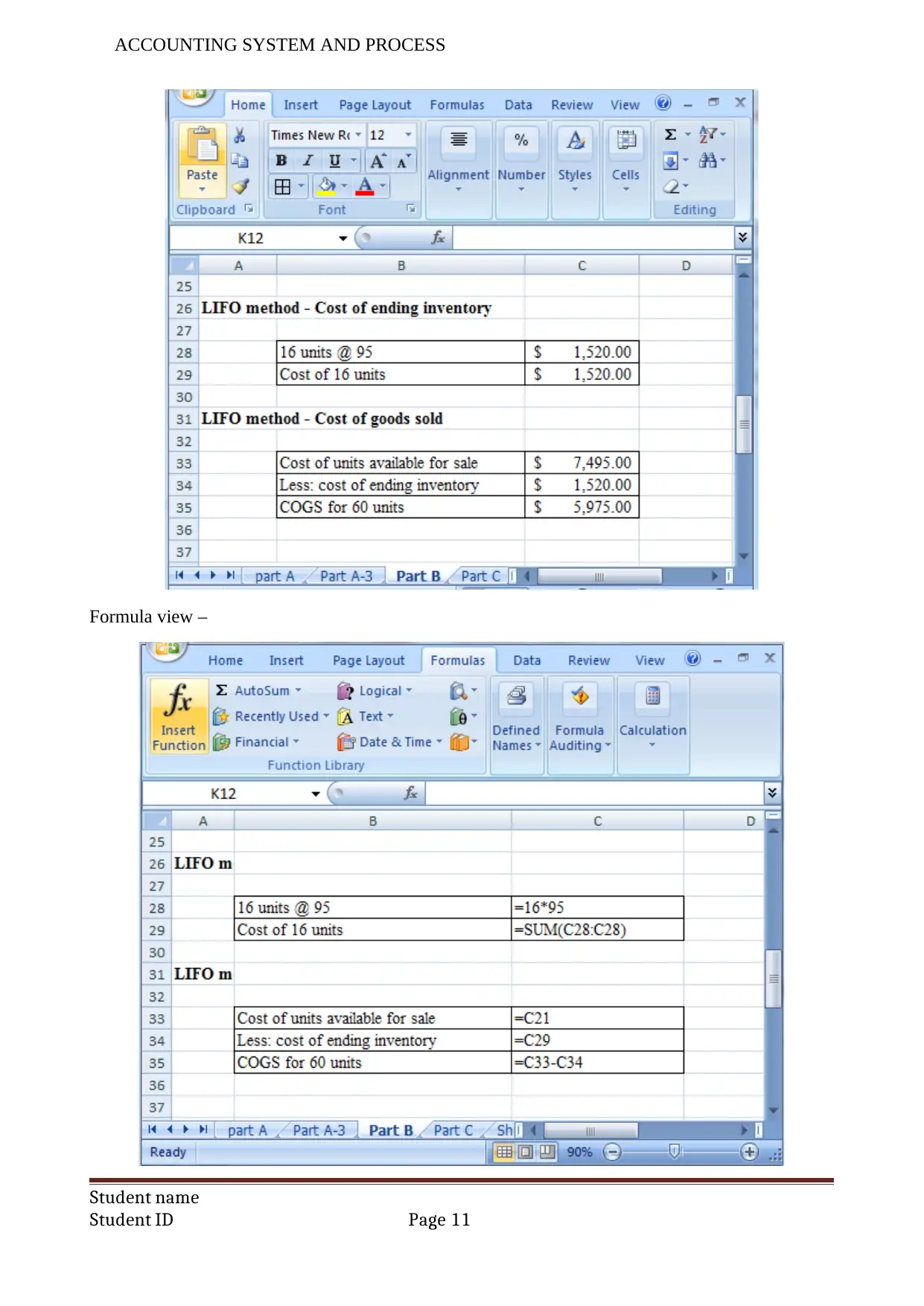
ACCOUNTING SYSTEM AND PROCESS
Formula view –
Student name
Student ID Page 11
Formula view –
Student name
Student ID Page 11
⊘ This is a preview!⊘
Do you want full access?
Subscribe today to unlock all pages.

Trusted by 1+ million students worldwide
1 out of 19
Related Documents
Your All-in-One AI-Powered Toolkit for Academic Success.
+13062052269
info@desklib.com
Available 24*7 on WhatsApp / Email
![[object Object]](/_next/static/media/star-bottom.7253800d.svg)
Unlock your academic potential
Copyright © 2020–2025 A2Z Services. All Rights Reserved. Developed and managed by ZUCOL.



